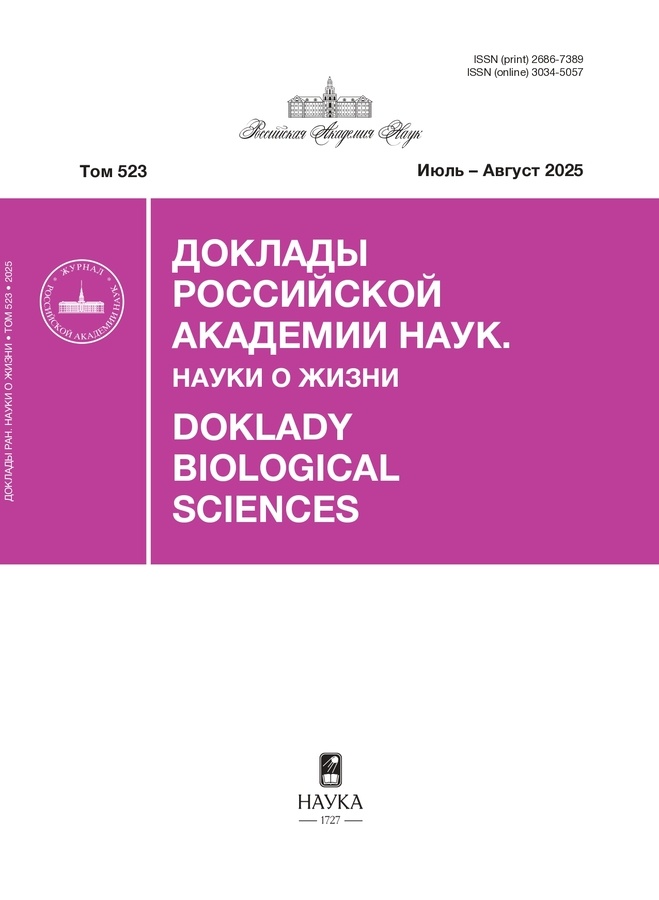Expression Level of Carotenoid Biosynthesis Genes in Leaves Is Associated with Cold Tolerance of Zea mays L. Plants
- Autores: Arkhestova D.K.1, Kochieva E.Z.1,2, Shchennikova A.V.1
-
Afiliações:
- Institute of Bioengineering, Federal Research Center “Fundamentals of Biotechnology” of the Russian Academy of Sciences
- Moscow State University
- Edição: Volume 523, Nº 1 (2025)
- Páginas: 457-461
- Seção: Articles
- URL: https://medjrf.com/2686-7389/article/view/693507
- DOI: https://doi.org/10.31857/S2686738925040133
- ID: 693507
Citar
Texto integral
Resumo
The expression profile of key carotenoid biosynthesis genes (ZmPSY1, ZmPSY2, ZmLcyE) was determined in the dynamics of cold stress and post-stress recovery in the leaves of Zea mays L. plants of four cold-resistant (breeders' data) inbred lines: L-5580-1, L-6097-1, L-5254-3 and L-5272-6. It has been shown that under normal growing conditions the expression level of all three genes in the L-5580-1 line is significantly higher compared to other lines. It was revealed that low-temperature exposure affects the trends of gene expression fluctuations in a similar way between the lines. It was determined that in the dynamics of stress, the leaves of L-5580-1 plants are characterized by coordination of the co-expression pattern of the ZmPSY1 and ZmPSY2 genes with changes in the carotenoid content.
Palavras-chave
Sobre autores
D. Arkhestova
Institute of Bioengineering, Federal Research Center “Fundamentals of Biotechnology” of the Russian Academy of Sciences
Email: shchennikova@yandex.ru
Moscow, Russian Federation
E. Kochieva
Institute of Bioengineering, Federal Research Center “Fundamentals of Biotechnology” of the Russian Academy of Sciences; Moscow State University
Email: shchennikova@yandex.ru
Moscow, Russian Federation; Moscow, Russian Federation
A. Shchennikova
Institute of Bioengineering, Federal Research Center “Fundamentals of Biotechnology” of the Russian Academy of Sciences
Email: shchennikova@yandex.ru
Moscow, Russian Federation
Bibliografia
- Waadt R., Seller C. A., Hsu P. K., et al. // Nat. Rev. Mol. Cell Biol. 2022. V. 23(10). P. 680–694.
- Kidokoro S., Shinozaki K., Yamaguchi-Shinozaki K. // Trends Plant Sci. 2022. V. 27(9). P. 922–935.
- Matsuoka Y., Vigouroux Y., Goodman M. M., et al. // Proc. Natl. Acad. Sci. USA. 2002. V. 99. P. 6080–6084.
- Afrouz M., Sayyed R. Z., Fazeli-Nasab B., et al. // Peer J. 2023. V. 11. P. e15644.
- Soualiou S., Duan F., Li X., et al. // J. Exp. Bot. 2023. V. 74(10). P. 3142–3162.
- Ma H., Liu C., Li Z., et al. // Plant Physiol. 2018. V. 178(2). P. 753–770.
- Waititu J.K., Cai Q., Sun Y., et al. // Genes (Basel). 2021. V. 12(10). P. 1638.
- Rosas-Saavedra C., Stange C. // Subcell. Biochem. 2016. V. 79. P. 35–69.
- Zunjare R.U., Hossain F., Muthusamy V., et al. // Front. Plant Sci. 2018. V. 9. P. 178.
- Gallagher C.E., Matthews P. D., Li F., et al. // Plant Physiol. 2004. V. 135. P. 1776–1783.
- Li F., Vallabhaneni R., Wurtzel E. T. // Plant Physiol. 2008. V. 146(3). P. 1333–1345.
- Li F., Vallabhaneni R., Yu J., et al. // Plant Physiol. 2008. V. 147(3). P. 1334–1346.
- Efremov G.I., Slugina M. A., Shchennikova A. V., et al. // Plants. 2020. V. 9(9). P. 1169.
- Bonnecarrère V., Borsani O., Díaz P., et al. // Plant Sci. 2011. V. 180(5). P. 726–732.
Arquivos suplementares










